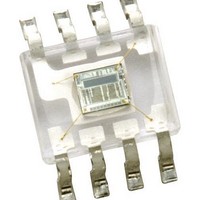TSL2550D TAOS, TSL2550D Datasheet - Page 7

TSL2550D
Manufacturer Part Number
TSL2550D
Description
Industrial Optical Sensors Ambient Light Sensor SMBus
Manufacturer
TAOS
Type
Ambient Light Sensor with Digital Outputr
Datasheet
1.TSL2550D.pdf
(20 pages)
Specifications of TSL2550D
Product
Ambient Light Sensor
Maximum Operating Temperature
+ 85 C
Minimum Operating Temperature
- 40 C
Lead Free Status / RoHS Status
Lead free / RoHS Compliant
Other names
TSL2550D-TR
Analog-to-Digital Converter
Digital Interface
The LUMENOLOGY r Company
The TSL2550 contains an integrating analog-to-digital converter (ADC) that integrates a photodiode current.
First it integrates channel 0 photodiode current and then it integrates channel 1 photodiode current. At the end
of the conversion cycle for each channel, the conversion result is transferred to the appropriate channel 0 or
channel 1 ADC register. The transfer is double-buffered to ensure that invalid data is not read during the transfer.
After the data is transferred, the TSL2550 automatically begins the next conversion cycle. A VALID bit is used
to indicate that data has been written to the ADC register after ADC is enabled.
Interface to the ADC and control of other device functions is accomplished using the standard 2-wire System
Management Bus (SMBus) interface. Both versions 1.1 and 2.0 of the SMBus are supported.
The ADC has two operating modes: standard and extended. In standard mode, the integration time is 400 mS
for each channel or 800 mS for both channel 0 and channel 1. Extended mode shortens the integration time
by a factor of five with a corresponding decrease in responsivity of 5
to operate at higher light levels, extending the overall dynamic range by a factor of five.
The TSL2550 contains an 8-bit command register that can be written and read via the SMBus. The command
register controls the overall operation of the device. There are two read-only registers that contain the latest
converted value of each of the two ADC channels. The SMBus slave address is hardwired internally as 0111001
(MSB to LSB, A6 to A0).
Both the send byte protocol and the receive byte protocol are implemented in the TSL2550. The send byte
protocol allows single bytes of data to be written to the device (see Figure 6). The written byte is called the
COMMAND byte. The receive byte protocol allows single bytes of data to be read from the device (see Figure
7). The receive data can be either the previously written COMMAND byte or the data from one of the ADC
channels. In Figure 6 and Figure 7, the clear area represents data sent by the host and the shaded area
represents data returned by the ambient light sensor or slave device.
S = Start Condition
S = Start Condition
1
S
1
S
Slave Address
Slave Address
PRINCIPLES OF OPERATION
Figure 7. Receive Byte Protocol
r
Figure 6. Send Byte Protocol
7
7
P = Stop Condition
P = Stop Condition
www.taosinc.com
WR
RD
1
1
A
A
1
1
Data Byte
Data Byte
Shaded = Slave Transmission
Shaded = Slave Transmission
8
8
×
. The extended range allows the device
r
1
A
1
A
1
1
P
P
AMBIENT LIGHT SENSOR
WITH SMBus INTERFACE
TAOS029L − OCTOBER 2007
Copyright E 2007, TAOS Inc.
TSL2550
7




















